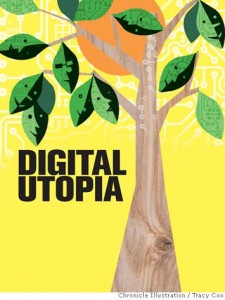Starting out in this course I really did not know what to expect. Starting out with the first few readings I had a hard time getting through them just because I did not fully understand the concepts they were explaining. However when we were told about the blog and the key terms that a person would individually research and post on the blog the readings got easier and more understandable. Also when we would discuss them in class it was like the pieces came together. The first few readings and concepts I found a little dry too and hard to focus on to absorb all the information, but as we got deeper into the course the more interesting things became. It was interesting to study memes and to realize and learn that memes are not just silly pictures and words combined but there’s an algorithm behind making them, and that the word meme is not just those but anything that is a running idea or imitation which could be a uniform religion or even something as simple as chairs. I would of never thought deeply enough into the subject to learn how different the word is to what I thought it was, and I didn’t know that it could be put under that big question of “what isn’t a meme?” just like the question “what isn’t science?”
Then there was Google. I learned a lot about Google because I was on the Google team. We heard so many negatives about the mega corporation, especially from Vaidhyanathan. Even so I am still a Google supporter. I love Google. The very serious issues Google could cause are future issues, but in the present it’s a great creation. Just as my group says, we just need to be wary for the possibility of Google in the future, since it is so relied on and has so much of our information. At the moment though Google is great! It’s like one of my best digital friends. Learning about Youtube, one of Google’s many bought-out services, was not as interesting as the other topics afterwards. What we learned about Youtube and it’s “Youtubers” did not interest me as much.
When we got to video games I loved learning about them, probably because I hold such a great interest and love for video games. I thought it interesting to hear about gender and racial problems that happen in video games. When I play it is usually just my friends teasing me and they usually call me a little boy because apparently that’s what I sound like over the microphone, but I just find it funny. Of course I usually never talk in public because I’m shyer around new players; maybe it’s because I think I’ll be made fun of for being a girl. I also loved watching the web series, I watched all of Awkward Black Girl just because I enjoyed watching it so much. I was upset when it was over. It was witty and called attention to racial stereotypes without being very serious or offending about it. I’m happy and excited for the Issa Rae television show coming out. She deserves to be on the big(ger) screen.
This course was very interesting and made me think about things I haven’t put much thought into. Class was long but it went by so quickly because of the content of the course just intriguing along with the discussions in the course. It was a great course and I am sad it’s over!


















